Mohammed Ali Bdour
Department of Plant Production, Faculty of Agriculture, Mutah University, Al-Karak, 61710, Jordan
Correspondence to: Mohammed Ali Bdour, Department of Plant Production, Faculty of Agriculture, Mutah University, Al-Karak, 61710, Jordan.
| Email: |  |
Copyright © 2014 Scientific & Academic Publishing. All Rights Reserved.
Abstract
The aim of this research was to study factors that are associated with the adoption of improved techniques aimed at increasing and improving quantity and quality of barley based crop in dry areas of Karak district. The study also was made for the purpose of studying the social and economic characteristics of farmers in relations to the adoption of Zero Tillage technique (Z-Tel technique). Hopefully, this technique will help farmers to improve their income, save time and efforts, as well as assist them to understand and realize the consequences of the negative impact of the climate change. Data was collected using a special questionnaire designed and tested for this purpose. Descriptive analysis was utilized, and percentages were identified. The results showed that farmers are welling to adopt the new techniques, where percentages found a high level of acceptance for adoption of new techniques, due to the close relevance of the factors associated with age (95%) under 60 years, educational level (93%) as educated, relevance of social and economic factors (90%) as medium and low income farmers. The relevance of social factors to the agricultural farming system (75%). The study also revealed that in order to adopt the Z-Tel technique, farmers should have access to new modified seeders as well as training of farmers on the new techniques in the livestock sector. The study recommend further research to be made in the field of extension activities to encourage farmers to adopt the new techniques.
Keywords:
Dry areas, Techniques, Barley, Factors that affect adoption, Agriculture extension
Cite this paper: Mohammed Ali Bdour, Factors that Affect Adaption of Improved Innovation Techniques for Barley and Sheep Farmers in Arid Area in Karak: A Descriptive Study, International Journal of Agriculture and Forestry, Vol. 4 No. 5, 2014, pp. 359-364. doi: 10.5923/j.ijaf.20140405.03.
1. Introduction and Problem of the Study
Inventions and innovations, for many centuries, have been the focus of talented people in all areas of science and technology to improve and enhance the livelihood of people all over the world. Many inventors have faced tremendous challenges in convincing their people of the advantages of their inventions. Unfortunately, many people believed that these inventions are against religious, culture or traditions. On the other hand, other people accepted these inventions and innovations and applied them in their real life situations, and as a result, spread to other nations, who benefited from them. But the question that needs to be answered, how these inventions and innovations spread and accepted by other nations? The Diffusion of Innovations (DOI) approach, was developed and updated by Rogers E.M. [1], for the purpose of helping Extension Agents (EA) in their duties, especially in convincing farmers with the new techniques and practices and allowing them to adopt them. The DOI is considered the most accepted approach, which answer the questions on how the new techniques will be explained, anticipated and judged. This was widely known and gave the definition of the diffusion process. Based on this definition, diffusion is defined as the process, in which new techniques are transferred to people through certain channels in a specific time among community people. This include all the main factors including time, social factors as well as the innovation itself, which affect the speed and rate of adoption based on the cost, clearance of its objectives, adaptability, acceptability, relevance and the farming methods used. The agricultural sector in Jordan is facing enormous challenges, especially the agricultural sector. Shortages of irrigation water, due to the climate change impact, is the most serious challenge facing not only agriculture, but also all sectors. The shortages of rainfalls, shifting the rainy season as well as the rainfall variations are few of many problems facing the dry land areas of Jordan, especially in the south of the country. According to ICARDA [2], the yield of barley was dropped to a minimum of 0.31 tons/ha, which affected livestock farmers and increased the overhead costs of raising animals. As a result, thousands of livestock farmers were affected and the social-economic conditions were affected.Usually, adopting to a new condition does not happen overnight and it takes time. Schipper, [3], believed that it depends largely on how to improve existing conditions as well as reinforcing existing policies and regulations.The dry land areas of Karak district is characterized by low rainfalls (200-350 mm annually). Farmers in these areas are depending on livestock as their main source of income. The main crops planted in this areas are cereal crops (wheat and barley) and legumes (lentil, vetch, chickpea). Most farmers are using local varieties that have low yield, have little land holdings and they use traditional wrong practices, especially in plowing their lands, [4]. As a result, the soil lost its organic humidity, structure and was deteriorating very fast. In addition, soil erosion has become a serious problem facing the Karak farmers.
2. Literature Review
A study entitled (Climate change in Jordan: A comprehensive comparison study) by Moshhrik, [5], was conducted for the purpose of identifying evidences about climate change impacts. Data collection from six climate stations in Irbid, Bagoorah, Deir Alla, Ma'an, Queen Alia International Airport and Amman Airport was obtained. The data was statistically analyzed to determine the changes accrued on temperate, humidity and rainfall variations for the last decade. The analysis showed that a temperature rise started in the early 70's and a slight change on rainfall variations also happened during the same period. The study also showed that a slight change in climate accrued during this period. Another study entitled "Climate change impact on the future of the Jordanian population” was conducted by Teruaki, Tayfour [6]. It was made for the purpose of investigating the needed strategic policy changes in energy, water and agricultural sectors. A mathematical equation was developed and used to evaluate the future of Jordanian population. The results revealed that the big increases in the consumption patterns by individuals as well as by the country as a whole are alarming. Results illustrated that even with the increase in production in all sectors of the economy, it still not enough to cover the entire gap. The results of the study demonstrated the urgent need for alternative sources of energy, optimization of water use as well desalinization of sea water and the use of new water saving techniques. All these measures are tactical policies for each sector. In addition, changing behavior and attitudes towards these issues as well as capacity building to enhance adoption abilities of the new developments are important factors to be considered. The study also emphasized the importance of using long term strategic policies for all sector.Amal, Alraw. [7] conducted about the adoption rate of new techniques by small ruminant farmers in Al-Anbar District, Iraq. discussed the same issue in their study. The purpose of the study was to determine the adoption rate of new technologies used by livestock farmers, their impact, the percentage of adopters and the main difficulties they faced. The study used regression coefficient, simple correlation coefficient, and frequency distribution. The results show a close relationship between the level of adoption and the variables of the study.About the same issue, Aljouhri and Katab, [8], conducted a study entitled “The rate of adoption of new techniques by maize farmers “in Karkook, Iraq. About two hundred farmers were surveyed by personal visits to investigate the reasons behind their reluctant (if any) to adopt the latest techniques. The study used different methods to analyze the data, including a survey, personal visits, as well as others. Results showed that an increase in the percent of adoption, occurred between 2000-2002, then a decline happened.In KSA, Alsakran and Muneer, [9] conducted a similar study, about the adoption of a new technology in palm tree growing, using the tissue culture. The study aimed at studying the social and economic impacts of adopting the tissue culture technique. Around 250 farmers were surveyed, using the personal visit methods as well as a questionnaire prepared and tested for this purpose. The results showed that about 87, 2 % of the surveyed farmers know the technique. It was also noted that only 14,5 % adopted the technique. The main reasons behind the low percentage of adoption are farmers lack of awareness of the comparative advantage of the technique, lack of their experience to apply it and its applicability. The study suggested more research to be done in this field, enhance the role of extension education in this regards and more information to be disseminated to farmers about the technique.Another conducted study in this area was the research work implemented by Shadya Awad [10]. The study entitled “The impact of socio-economic factors on the adoption rate of local mushroom varieties in rural Syria” aimed at introducing socio-economic conditions of farmers in the study area as well as the effect of these factors on the adoption rate of mushroom planting. Around 120 mushroom farmers from the study area were surveyed using a questionnaire prepared for this purpose. The study indicated that there is a positive relationship between education and adaption rate. The study suggested the encouragement of establishing farmers’ association as well as marketing centers in each village.Alshami and Alrimawi, [11], also carried out a study related to the same subject in Jordan. The study entitled “Analysis of the attitudes of food plants administration in Jordan toward the adoption of quality management systems” aimed at measuring and analyzing the attitudes of food factories in Jordan toward the adoption of quality management system, getting acquainted with quality control issues applied in food processing factories, as well as the opinions of their management teams in applying these standards. The study sample includes 80 factories. The study showed that the adoption rate of such sample to quality control measures and standards are less. It also suggested an increase in the capacity building in areas of statistical methods of quality control, enforcing quality control measures, provide financial and technical assistance as well.
3. Definitions
Project: is defined as an activity prepared to allow farmers in dry land areas to use certain techniques that will help them to improve their production and give them a better understanding of the climate change and how to cope with its negative impacts. Funded by IFAD and the two governments of Iraq and Jordan, and jointly implemented by ICARDA in cooperation with the National Center for Agricultural Research and Extension (NCARE), Mutah University and the Management of Agricultural Resources Project-Ministry of Agriculture.Dry Areas: The dry areas are characterized by low rainfalls variations and an increase of daily and annual temperature means. The measurement used to determine that is the difference between the amount already fallen and the evaporated amount (Evapo-transportation). Hence, the dry areas have more evaporation than falling rainfalls. The UN definition, [12], of dry lands is "Dry areas, semi-dry areas, other than polar areas and semi polar areas, where the ratio between annual rainfalls and Evapo-transportation do not exceed, (0.05-0.65).No Tillage: Called also as Zero Tillage (Z-Tell). Is a method of planting seeds without plowing the soil. Made to protect the soil from losing the soil moisture. The remains of the previous crop are left in the field to increase the organic materials in the soil, which improve the soil structure and fertility, [13]. Such process allows soil moisture to stay in the soil layers and protect it from soil erosion. The zero tillage help farmers to cope with the negative impact of the climate change, specialty the low rainfall variations and the shifting in the rainy season. It also allow farmers to save money, time and efforts as well as fuel used in the plowing , and a s a result reduces the CO2, which is considered as the main factor in the ozone layer damage. Willingness to Adopt: refers, in this study, to farmers' willingness to adopt the new applied technique. It also determine whether or not the farmer is willing to adopt the Z-Tell, artificial insemination, techniques to improve production and mastitis diagnosis through the use of special kits. Such techniques allow farmers to have better production, healthy animals and synchronization of born animals.Agricultural land holding: an agricultural production unit, which include animals as well as areas used for planting crops, and include all lands used fully or partially for production.Size of land holding: was set by the department of statistics [14] as "anyone who own one donum or more of agricultural land, ten goats or sheep, one cow, one camel, 30 beehives, or 30 chickens or more or a cattle farm or poultry farm.
4. Goals of the Study
1. Get acquainted with farmers' characteristics in dry areas of Karak district.2. Determine the level of adoption of the techniques introduced by the project (mastitis diagnosis, Z-Tell and, artificial insemination). 3. Determine the reasons behind farmers hesitation for adoption of the mentioned techniques.
5. Materials and Methods
The study area of the project "Improving Food Security and Climate Change Adaptability of the Livestock Producers using the Rainfed Barley-based System in Iraq and Jordan", included all areas of the Karak district, where rainfalls range between 200-350 mm. The estimated number of farmers in this area are 600 and distributed in three agricultural areas; Eder, Smakieh and Sol villages. These areas have an average rainfall between, 200-350 mm. Most of the farmers depend largely on raising livestock, especially sheep and goats using barley based system.A random sample of 43 farmers, composing around 7% of the total farmers population was selected using special questionnaire prepared for this purpose. The data was collected through personal interviews and special meetings with the study audience.The questions were divided into five groups; Personal information (age, educational level and marital status), factors associated with the technique itself (cost, clarity, simplicity, adaptability, and level of acceptance). The third group of questions are related to cultural aspects (norms, customs and cultural habits) and natural environment (soil) and environmental aspects. The fourth group of questions are related to sources of (researchers, extension agents, media, TV, radio, magazines and newsletters. The fifth group of questions were related problem that face farmers to adapt new techniques that mentioned earlier. A pre-test was conducted using a random sample of 10 farmers representing the population. Statistical analysis software (SPSS) was used to analyze the data.
6. Results and Discussion
1-Personal factors group.1-1: Age: the result of this survey study (Table 1) showed that around 4.6% of farmers are under the age of 40 years. On the other hand, 95.4% of the farmers were considered middle -aged (40-60 years old). These results gives a good indication of a possible rise in the level of adoption among farmers. Most studies showed that the rate of adoption increase when farmers are young or in middle age.Table (1). Distribution of the sample according to age*
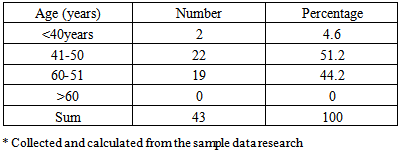 |
| |
|
1-2: Education Level: results showed low illiteracy rate (table 2) among farmers (4.6%), while 53.5% of farmers were had secondary education level or above. education level in the current study revealed that adoption of technologies is likely possible to improve barely productivity and sheep breeding in the target area.Table (2). The Distribution the of the sample according education levels *
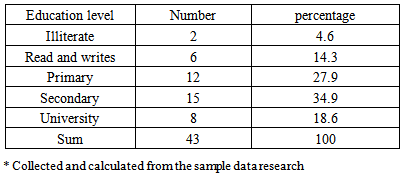 |
| |
|
1-3: Holding size: - the results of this study showed that more than 53.5% of farmers have small holding size farms and around, 58.2% of farmers had small sheep herd. On the other hand, 41% of farmers had a holding size that range from, 100-300 dunums, and 37% had medium herd size (range from 100-300 head of sheep). These results showed that there is a positive correlation between land holding size and sheep herd size. These results also suggest that as holding size decreases, there will be a higher potential to adapt new techniques to improve productivity of their farms and thus their income.Table (3). Distribution of the sample according to the size of the agricultural holding *
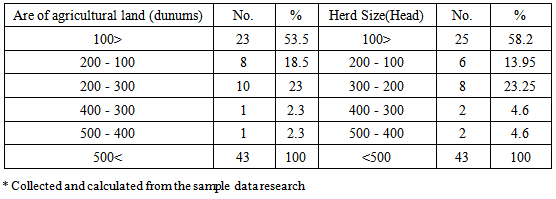 |
| |
|
1-4: Social status and economic situation: The results of this study showed that both social status and economic situation is acceptable for adaption of new techniques (Table 4). This results is based on the fact that more than 90% of farmers are considered to have normal and prestigious social level. In addition, around 91% of farmers had acceptable economical conditions. A direct correlation between economic situation and adoption of new agricultural technologies where likelihood of adoption increased for those with medium and good economicTable (4). Distribution of the sample according to the Social status and Economic Situation *
 |
| |
|
2-Combination of factors relating to technology itself: As shown in table 5, 75% of farmers noticed an increase in their farms average production. However, only 23% of farmers noticed reduction in cost of production. These results indicated that 50% of farmers noticed both increase in their farm production and at the same time reduced production cost. These results may give a clear indication that the technologies that being adapted found a high acceptance by farmers (Table 5).Table (5). Distribution of the sample according the comparative advantage to ( Z-Tell) farming techniques and improve the productivity of sheep *
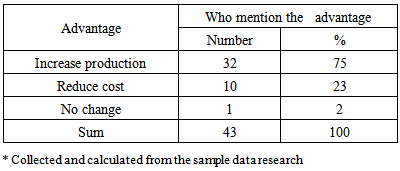 |
| |
|
Data in table 6 showed the distribution of the sample by the costs of technology, and the clarity of the results, and limited possibility of application. It can be seen that more than half of farmers found that adaption of new technologies is not expensive and found that application of these technologies are simple to be applied. On the other hand, around 70% of farmers found that adaption of new technologies are clear almost half of farmers found that these technologies are moderately expensive. It can be predicated that a high rate of adaption of technologies between farmers can be achieved.Table (6). Distribution of the sample by the costs of technology, and the clarity of the results, and limited possibility of application *
 |
| |
|
3-Combination of factors related to the environment:3-1: Social environment Table 7 shows the applicability of innovated techniques in relation to social, environmental and climatic environment from farmers prospective. These results showed that 52% of farmers found that social environment is completely appropriate; however, 37% of farmers found that these techniques are Inappropriate and the rest of farmers found techniques are absolutely inappropriate. On the other hand, more than 85% of farmers found that both natural environment and Climatic environment are Completely appropriate. These results suggest that environmental barriers can slightly influence adaption of new technologies and karak area has the potential in adopting improved technologies for barley and sheep farmers.Table (7). Distribution of the sample according to ratio appropriate techniques to factors related to environment *
 |
| |
|
4- Sources of information for farmers:The results in table 8 explain the main source of agricultural information were farmers can gain technical advices. It can be clearly seen that the main source of information gained from (in descending order) agricultural extension agents, followed by relatives, friends and neighbors, researchers in the research centers, journals and newsletters guidance, daily newspapers , television and radio programs.Table (8). Distribution of sources of information according to the number of farmers who are exposed *
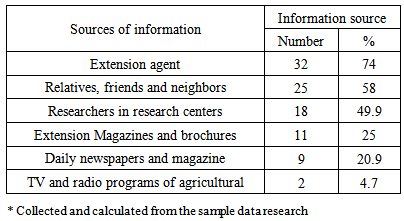 |
| |
|
Results clarified that farmers in dry areas, deriving their knowledge of agricultural from multiple sources, and they are linked to most of the means and channels of communication guidelines, making it easier to extension theme in the deployment of technologies designed to mitigate the effects of climate change on dry areas, where they can use the channels of communication guidelines appropriate stages of campaigns indicative different, with access to a large number of farmers.5-Farmer willingness to Adopt the techniques of (Z-Tell) and improve the productivity of sheep:Table 9 shows distribution of farmers according to their willingness to adopt the techniques of Z-Tell and improve overall sheep productivity. These results showed that majority of farmers are willing to adapt the use of (Z-Tell) Techniques in the cultivation of barley (93%), insertion of sponges hormones (63%), early detection of mastitis (88%) and to less extent adapting artificial insemination (53%). High percentage of desired and undecided in the application of these techniques which aimed to help the residents of dry areas to cope with the drought conditions causing by climate change, gives a positive indication of suitability of this technology and its compatibility with the agricultural system in the dry areas of Karak.Table (9). The distribution of the sample according willingnes to Adopt the techniques of (Z-Tell) and improve the productivity of sheep *
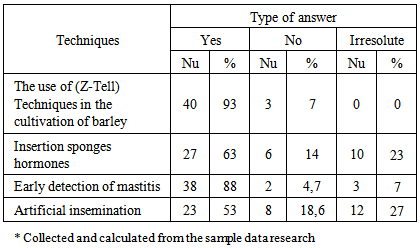 |
| |
|
6-Problems faced farmers in the adoption of technologies:Been identified on the responses of farmers on the most important problems they faced when applying the techniques of conservation agriculture (No-tillage) , and techniques to improve the productivity of sheep (table 10).Results in table 10 shows the problems facing farmers in applying the techniques to improve overall production. It can be clearly seen that the main problems facing barley farmers are lack of seeders (88%) and low amount of rain (88%). For sheep farmers, unavailability of materials needed to detect of mastitis and installing sponge’s represented the main problem facing them (93%). A lack of training to apply techniques of livestock production is also can be considered as a one of the major problems facing farmers (74%). High Cost of apply techniques of livestock production is considered as a major problem in adapting new technology such as artificial insemination and sponge insertion. Other problem such as land topography (i.e land slope) and Fear of failure of trial in the first time are considered with little importance among farmers.Table (10). Distribution of the sample according to the problems facing them in applying the techniques to improve production *
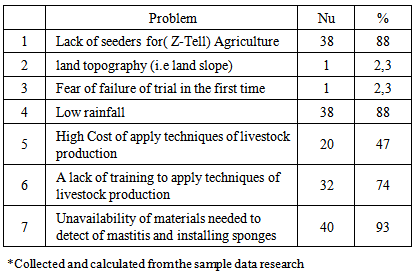 |
| |
|
7. Conclusions
The aim of this research was to study factors that are associated with the adoption of improved techniques aimed at increasing and improving quantity and quality of barley based crop in dry areas of Karak district. The obtained results indicated that farmers in Karak are willing to adopt the techniques described by this study. The results indicated that farmers are ready to use the project techniques, high percentage of this prediction is based on the study results of some factors related to disseminated techniques. Where these techniques related with personality factors for the farmers, the educational level as a result of decreased illiteracy rate between the farmers sample to 6.4% and high percentage of them are in the secondary education level or above, where the percentage reached 53%. Also results indicate that the economic situation and social status of farmers affect the percentage of using the mentioned techniques which reached to 90%. Combination of factors related to the technology itself, the results showed that 75% of farmers increased their own production after using the improved techniques, 23% of them achieved a reduction of production costs when they use the new technologies, and this indicates that there is economic priority for the improved technologies than the traditional methods used by the farmer which helps to increase the rate of adopting the project techniques. The results showed that 58% of farmers believe that the technologies being applied consistent with previous experience of the farmer and the farming system in the dry areas. The technology characteristics in terms of their costs and clarity of its results after application in their fields the technology can be applied partially in farmers' fields by up to 91%. Thus, it can be concluded a high rate of adoption by the farmers. This survey revealed barriers that reduce adaption of innovation in arid areas such as presence of seeders and training. More focuses must be given to agriculture extension agents to strength the future possibility to eliminate these barriers.
References
| [1] | E. M. Rogers, (2003). Diffusion of Innovations, 5th ed, New York: Free Press. |
| [2] | International Center for Agricultural Research in the Dry Areas, (ICARDA), 2008, West Asia Regional program Project, Improving food security and adaptability to climate change for livestock producers in rain fed barley – based farming system in Iraq and Jordan. |
| [3] | E. Lisa. F. Schipper 2008 Maria Paz Cigar á n Stockholm Environment Institute. |
| [4] | FAO, and, CAB, International 2007. N0-tillage Seeding in Conservation Agriculture, 2nd edn. (eds C. J. Baker and K. E. Saxton). |
| [5] | Hamdi, R, Moshrik,and, Mahmud Abu-allaban, 2009, Chlimate change in Jordan: Comprehensive Examination Approach, American Journal, of Environmental Sciences, vol, 5No,1, p, 58-68. |
| [6] | Teruaki, Ohnishi, Wa’il .Tyfour 2007, Assessing The Effect of Global climate Change on the Future Jordanian society, (2): Implication, Dirasat: Engineering Science, Vol 34, No, 1. |
| [7] | Alraw. Aml. 2011, The adoption of livestock keepers to modern practices in some agricultural areas in the province of Anbar, Diyala Journal of Agricultural Sciences, vol, 2 No, 3, p, 2015-205. |
| [8] | Al-Jubouri and katab, 2009, Adoption rate of Corn cultivators for agricultural innovationsin Hawija district/Kirkuk governorate Tikrit University Journal of Agricultural Sciences, Vol, 9, No, 1. |
| [9] | Muhamed S. Al-Sakran, and Siddig E. Muneer, 2010, Adoption of Date Palm Tissue Culture Technology Among Date Palm Producers in the Central Region of Saudi Arabia, Res. Bult., No. (145), Food Sci. & Agric. Res. Center, King Saud Univ., pp. (5-23) 2006. |
| [10] | Awad. Shadia. 2009, Effect of social and economic factors in the diffusion and adoption of the cultivation agricultural mushroom in Syrian rural area, Master Thesis, University of Aleppo Faculty of Agriculture. |
| [11] | Shami, Ammar, and, Al-rimawi, A. 2004, Analysis of the attitudes of food plants administration in Jordan toward the adoption of quality management systems. Dirasat: Agriculture sciences, Volume, 31, No, 2. |
| [12] | The United Nations Convention to Combat Desertification, 1994. UNCCD website at http://www.unccd.int. |
| [13] | D. Knowler, B. Bradshaw and D. Gordon, 2001, The Economics of Conservation Agriculture, FAO. |
| [14] | Jordanian Department of Statistics, the agricultural census sixth, 2007. |

 Abstract
Abstract Reference
Reference Full-Text PDF
Full-Text PDF Full-text HTML
Full-text HTML








